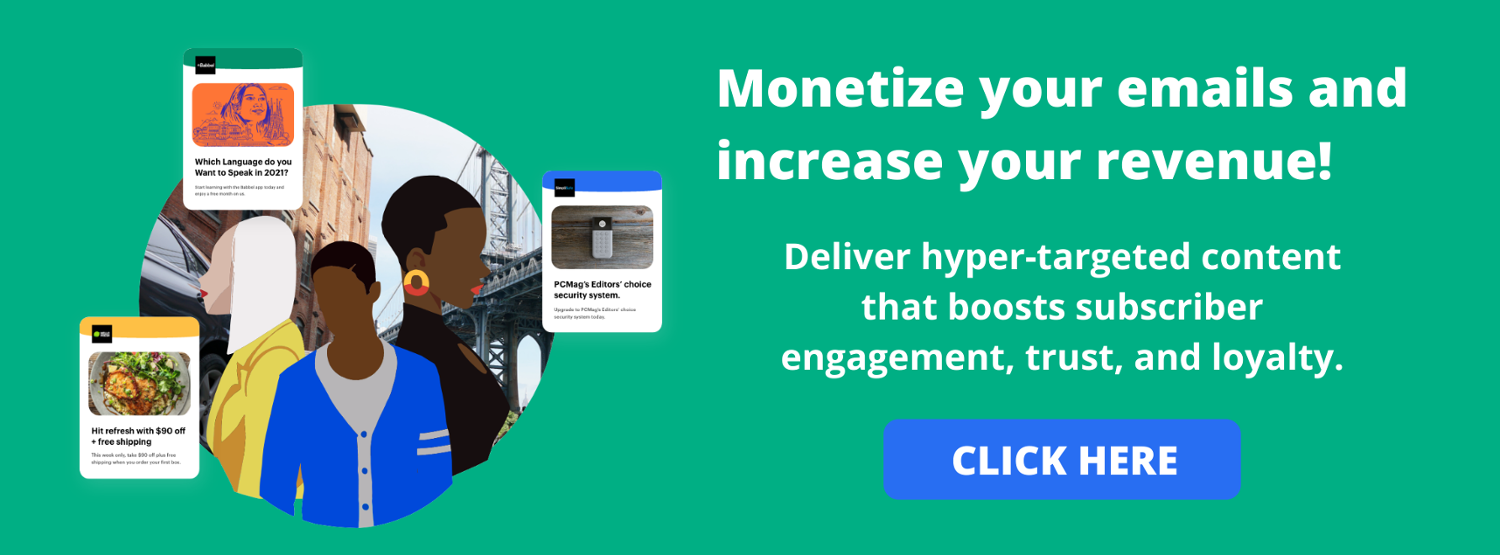As publishers prepare for the death of the third-party cookie (now scheduled for the end of 2023), they’re in dire need of new ways to fortify their bottom lines and optimize their targeting strategies.
One of the best solutions is to pivot towards email newsletters and build a strong newsletter strategy.
Over 4 billion people use email, with that number expected to reach 4.6 billion by 2025. And, as eMarketer reported, consumers prefer to hear from brands via email — more than via the apps, social platforms, or text.
Even millennials and Gen Z are tied to email, checking it several times a day and calling it their favorite channel for receiving real-time alerts. Litmus also found that email marketing has an ROI of 42:1. So for every $1 brands spend on email, they get $42 in return.
With all of its benefits combined, email can be the soothing balm needed to heal the wounds of a cookieless world — even amid rumblings of new email privacy features from Apple. Not to be too dramatic, of course. But as we face an event that’s about to affect 65% of all web traffic, it’s best to be prepared.
So, for publishers and advertisers seeking the next big thing in marketing, they have to look no further than one of the oldest, most time-honored channels on the web: email.
Here’s why.
The biggest benefits of email marketing
Email is ripe with opportunities to drive engagement and revenue, and reach customers with one-on-one messaging.
Access valuable first-party data
As third-party cookies are being phased out, publishers and advertisers are turning their attention back to first-party data. After all, it’s data that they can control since it comes directly from customers — unlike the data that gets locked behind the walled gardens of Facebook and Google.
One of the best ways to gather first-party data is through email. Customers can enter their email address when signing up for a newsletter, starting a free trial, or becoming a subscription member. Email is also opt-in, so customers know they’re choosing a trustworthy, privacy-safe channel through which to receive content, and brands know they’re reaching only those high-quality readers who want to hear what they have to say.
Nurture direct audience relationships
Email is a one-to-one platform, so each message you send will reach each reader directly. Meaning, it won’t get lost in a never-ending feed of posts from other brands, friends, and family members. When a customer opens an email, it’s just you and them, and that helps build trust and respect in an age where trust in the media is waning.
In fact, 58% of consumers say the number-one reason they’re enticed to read an email is because they trust the publisher while only 34% trust social media as a news source. Roughly half of Gen Z readers also say they’ll subscribe to an email newsletter because they trust the publisher.
With this trust and direct contact, publishers can nurture audience relationships, drive traffic back to their site, and upsell subscribers to increase revenue.
Drive revenue through monetization
Email offers prime real estate for ad inventory, promising ad partners direct access to built-in, captive audiences. According to Campaign Monitor, email drives the highest marketing ROI — more than its search, social, and affiliate counterparts.
This additional revenue stream is particularly important for publishers that are struggling to make up for lost on-site ad revenue during the pandemic. Many have already invested in subscription acquisition, and now they can monetize those loyal audiences with in-email ads, such as banner ads, text ads, and native ads.

How to build a robust newsletter strategy
Now let’s dive into how businesses can enjoy the benefits for themselves and develop email newsletter strategies that drive results.
Segment audiences for targeting
All emails shouldn’t be alike. Use that first-party data to segment newsletter audiences based on their behaviors, demographics, and preferences.
A tech publisher, for example, can create unique audiences of readers who:
- Read all of their emails and are eager for more content
- Have become inactive and need incentive to re-engage
- Are free subscribers and can be up-sold to become paid members
- Left products in their cart and need to be reminded to checkout
Publishers can even build segmented data into the sign-up process by asking users to specify which types and frequency of newsletters they prefer to receive. A preference center page, for instance, can ask readers whether they want daily, weekly, or monthly emails, and whether they’re interested in breaking news, trending topics, or occasional roundups of stories. You can also drill down even further to the time of day and channel they prefer.

Personalize your messaging
With that segmentation comes opportunities to deliver personalized emails that speak to each audience’s interests. In fact, this customization is a necessity when consumers are overwhelmed by content choices and channels. You need to grab their attention with relevant messaging.
As Innovid reported, 43% of consumers believe ads should be personalized, and 41% bought a product because of a personalized ad. Accenture also found that 83% of consumers are OK with sharing data if they receive personalized content in return.
An automated email platform can make this vital process easier for publishers and brands. It can be equipped to analyze your website content, build audience segments, and automatically send personalized content to each group of readers.
Enable different ad formats
Email supports many different ad formats, so publishers can sell a healthy mix of inventory, including display ads, native ads, and text ads.
Native ads, for example, blend in with their surrounding content, providing a more intuitive and seamless experience for the user.
Banner ads in email can also take the form of standard display sizes set by the Interactive Advertising Bureau, as well as custom ad sizes to fit the design of each email layout. The more ad formats publishers enable, the more opportunities they have to monetize their audiences and increase revenue.
Combine email with multichannel outreach
Email can be synced with other high-engagement channels, such as push notifications, websites advertising, and newsreader apps to help publishers increase their scale and digital footprint.
Especially if you gather first-party data from email, you can use that information to optimize campaigns on other platforms and create a comprehensive view of each customer’s journey as they interact with your company.
Meaning, email is a valuable solution but it doesn’t have to act alone. In fact, better if it doesn’t! Done right, it can feed and inform each sector for your business, future-proofing your marketing operation for a world where third-party cookies are just an afterthought — and first-party data reigns supreme.


